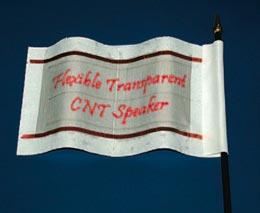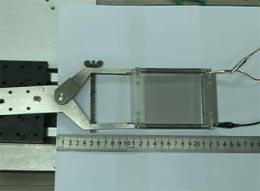Stretchy carbon sheets act as loudspeakers.
 The flexible nanotube loudspeaker even works when attached to a flag (roughly 8 cm by 14.5 cm).Jiang Kaili et al., ACS Nano Letters
The flexible nanotube loudspeaker even works when attached to a flag (roughly 8 cm by 14.5 cm).Jiang Kaili et al., ACS Nano LettersStretchable, flexible, transparent sheets of carbon nanotubes can serve as loudspeakers, Chinese researchers have found1. The loudspeakers can be tailored into any size and shape, they say – and to prove their point, they have put one on a waving flag.
Physicist Kaili Jiang at the Tsinghua-Foxconn Nanotechnology Research Centre in Beijing and his colleagues created their loudspeakers from sheets of parallel carbon tubes, each about 10 nanometres across. When they applied an electric current alternating at an audio frequency to these thin films, they were surprised to find that the material could make sounds as loud as commercial speakers.
"It is so wonderfully simple, that it brings up a strong wave of 'Duh, why didn't I think of that!'," says physical chemist Howard Schmidt at Rice University in Houston, Texas.
The nanotube loudspeakers could be stretched to up to twice their original size without breaking and with little change to the intensity of the sound. Their transparent nature could allow them to be placed on windows, video screens, or paintings, the researchers suggest, and their flexibility could allow them to be wrapped around pillars or even be put on clothing. The researchers have already attached one of the transparent films to the screen of an iPod, to play sound from the device.
A sound like thunder
Conventional loudspeakers generate sound by vibrating back and forth. However, when the researchers shone a laser vibrometer on their nanotube loudspeaker, they found it did not vibrate as it emitted sound.
 The carbon nanotube thin-film loudspeaker produces the same sound even while being stretched up to twice its original size.Jiang Kaili et al., ACS Nano Letters
The carbon nanotube thin-film loudspeaker produces the same sound even while being stretched up to twice its original size.Jiang Kaili et al., ACS Nano LettersInstead, it generates sound much as lightning produces thunder. When an electric current is applied to the nanotubes, they heat and expand the air near them, creating sound waves. "The difference is that thunder is not a controlled discharge. With carbon nanotubes, you can control the sound and play music," Jiang says.
The heat generated by these loudspeakers can be controlled by how much power they receive — speakers working at ambient temperatures would be preferred for most consumer applications, he adds.
A similar thermoacoustic effect was seen in the late nineteenth century, leading to an invention dubbed the 'thermophone'. However, this device, made with thin metal films, produced extremely weak sounds.
The scientists found that their device was some 260 times more efficient at generating sound than a platinum thermophone. This is because the nanotube film can both heat up faster and transfer its heat to air more rapidly than a thermophone can.
Hot stuff
“It is so wonderfully simple, it brings up a strong wave of 'Duh, why didn't I think of that!'”
Howard Schmidt
Rice University, Houston, Texas
Previous research from materials scientist Pulickel Ajayan, now at Rice University, and his colleagues had shown that carbon nanotubes could generate sound when exposed to light2. However, Ajayan says that the idea of using nanotubes as loudspeakers was new, and "very imaginative and creative".
"Plainly," Schmidt says, "there are a lot of consumer electronics applications for this idea." He adds that future research could explore how well such loudspeakers perform in liquids, perhaps finding use in underwater sonar or miniaturized ultrasound devices.
Ray Baughman, director of the NanoTech Institute at the University of Texas at Dallas, says that he "could even imagine electronic textile-based clothing for injured soldiers or those who are mentally or physically impaired, where spoken words formulated using sensors and computational capabilities embedded in the clothing might help direct the efforts of doctors".
"In the nearer term, these nanotube sheet loudspeakers might provide an economically attractive alternative to loudspeakers in greeting cards, which now comprise a piezoelectric sandwiched between two electrodes," he adds.



No comments:
Post a Comment